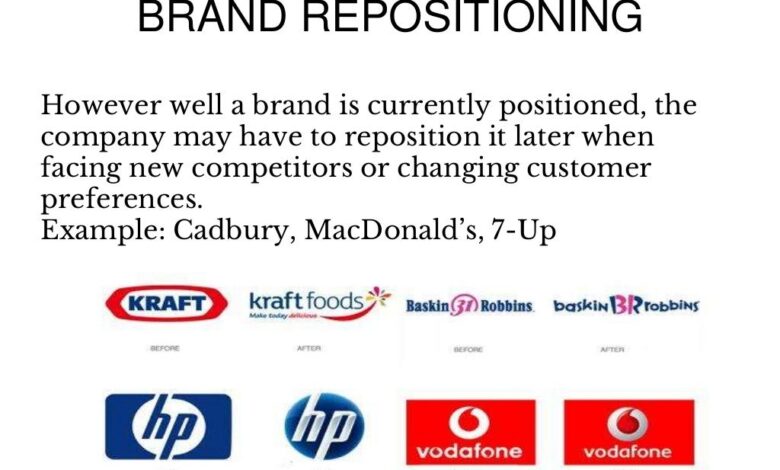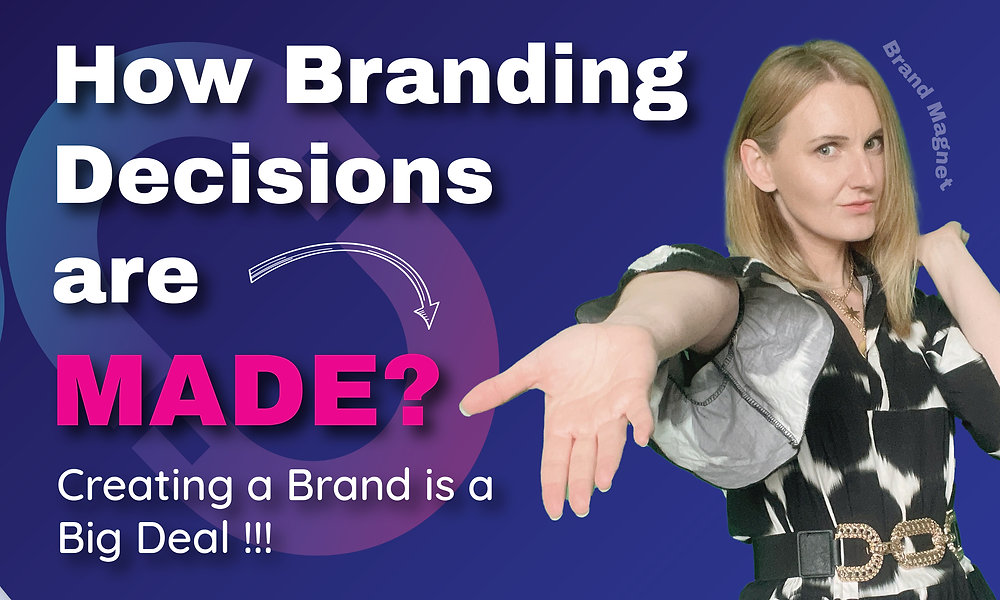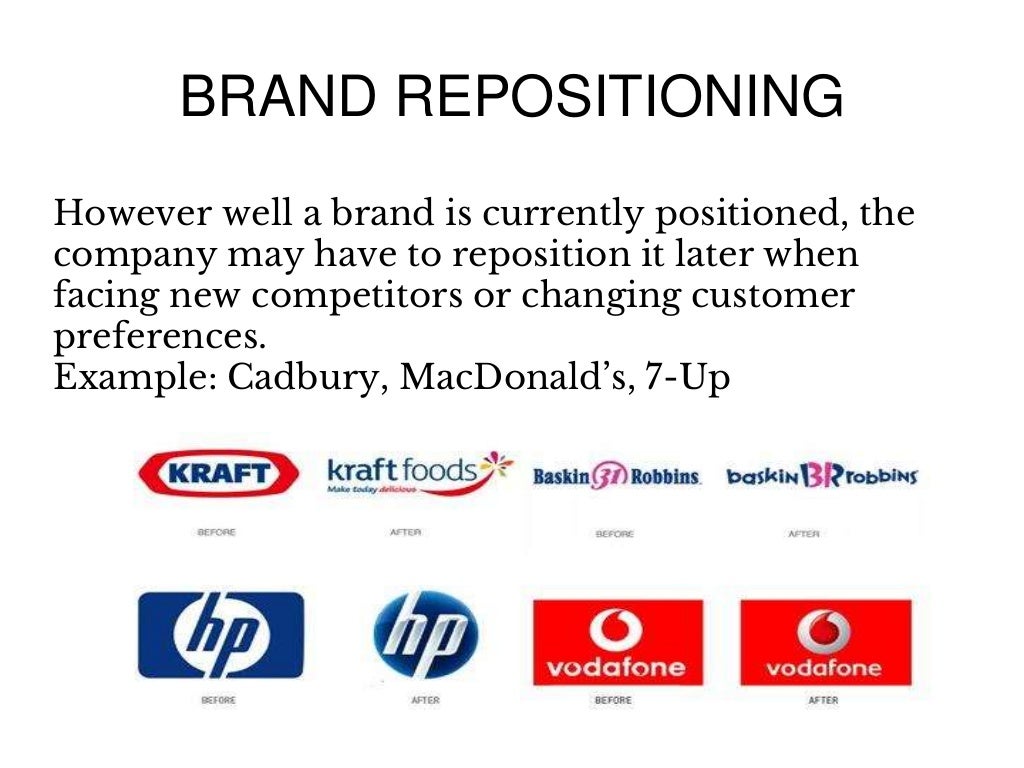
The Big Branding Decision A Deep Dive
The big branding decision – it’s a moment that can make or break a company. From subtle tweaks to complete overhauls, a brand’s identity is its most valuable asset. This post explores the complexities of making significant branding changes, examining the factors to consider, the processes involved, and the potential outcomes – both positive and negative. We’ll delve into real-world examples, hypothetical scenarios, and offer a practical framework to navigate this crucial business challenge.
We’ll cover everything from identifying internal and external influences on your branding choices to developing a robust risk mitigation strategy. We’ll also explore the crucial role of data analytics in informing your decisions and discuss how to effectively communicate major branding changes to stakeholders. Get ready to unlock the secrets to successful brand transformations!
Defining “The Big Branding Decision”
A “big branding decision” isn’t just about changing a logo or tweaking a tagline; it’s a strategic move that significantly impacts a company’s identity, market perception, and ultimately, its bottom line. These decisions often require extensive research, careful planning, and significant investment, carrying considerable risk and potential for substantial reward. The magnitude of the impact distinguishes a “big branding decision” from smaller marketing adjustments.The concept of a “big branding decision” varies depending on the business context.
For a small startup, a rebranding might be considered “big” if it involves a complete overhaul of their visual identity and messaging to target a new market segment. For a multinational corporation, a “big branding decision” could involve a global repositioning campaign costing millions, designed to address a decline in market share or to enter a new, highly competitive market.
The scale of the decision, its potential impact on the company’s reputation and financial performance, and the level of resources committed to its execution all contribute to its classification as “big.”
Examples of Big Branding Decisions Across Industries
Several industries offer prime examples of impactful branding decisions. In the technology sector, Apple’s consistent focus on minimalist design and user experience has been a cornerstone of their branding success, a decision that continues to shape their product development and marketing strategies. Conversely, a company like Microsoft has undergone significant branding shifts over the years, moving from a more corporate image to a more approachable and consumer-friendly one.
In the fast-moving consumer goods (FMCG) sector, consider Coca-Cola’s decades-long commitment to its iconic logo and brand imagery – a testament to the power of consistent branding. In contrast, a company like Pepsi has experimented more frequently with its branding, reflecting its efforts to maintain relevance with changing consumer preferences. These choices, whether maintaining a consistent image or undergoing a major transformation, represent big branding decisions due to their far-reaching implications.
Real-World Case Studies of Significant Branding Changes
One notable example is the rebranding of Gap in 2010. The company unveiled a new logo that was widely criticized for its simplicity and lack of connection to the brand’s heritage. The negative public reaction forced Gap to quickly revert to its previous logo, highlighting the significant risks associated with major branding changes. This case underscores the importance of thorough market research and testing before implementing such significant alterations.
Another example is the evolution of Starbucks’ branding. While maintaining core brand elements, Starbucks has subtly adapted its branding to reflect changing consumer trends and societal values, incorporating more sustainable practices and inclusive messaging into its overall brand narrative. This gradual evolution, while less dramatic than Gap’s experience, still represents a significant strategic branding decision.
Hypothetical Scenario: A Fictional Startup’s Big Branding Decision
Imagine a fictional startup called “EcoFlow,” producing sustainable, solar-powered home energy solutions. Initially, their branding focused on technical specifications and efficiency, targeting environmentally conscious homeowners with a high level of technical expertise. However, after conducting market research, EcoFlow realizes their target audience is broader—including environmentally conscious consumers who are less technically inclined but desire convenient and reliable energy solutions. Their “big branding decision” would be to reposition their brand, shifting from a purely technical focus to emphasizing ease of use, sustainability, and family-friendly features.
This would involve redesigning their website, updating their marketing materials, and potentially adjusting their product packaging to reflect a more approachable and consumer-friendly image. This change would represent a significant investment of time and resources, requiring a complete re-evaluation of their marketing strategy and potentially even their product design. The success of this decision would depend on their ability to effectively communicate this new brand identity to a wider audience.
Factors Influencing the Decision
Choosing a new brand identity or making significant changes to an existing one is a complex process, influenced by a multitude of internal and external factors. Understanding these factors is crucial for making informed decisions that align with the company’s overall objectives and market realities. A successful rebranding hinges on a thorough assessment of these interwoven influences.
Internal Factors Affecting Branding Decisions
Internal factors are those residing within the organization itself. They represent the company’s inherent strengths, weaknesses, and capabilities. These factors significantly shape the feasible branding options and the overall direction of the rebranding effort. Ignoring them can lead to a disconnect between the brand and the reality of the company’s operational capabilities.
Company culture plays a vital role. A brand needs to authentically reflect the company’s values, mission, and employee attitudes. For example, a company with a collaborative and innovative culture should project a brand that embodies those qualities. Similarly, available resources, including budget, personnel, and technology, directly impact the scope and complexity of the rebranding project. A limited budget might necessitate a more streamlined approach, focusing on key elements rather than a complete overhaul.
External Factors Affecting Branding Decisions, The big branding decision
External factors represent the forces operating outside the company’s direct control. These factors are dynamic and require continuous monitoring to ensure the brand remains relevant and competitive. Failure to adapt to external changes can render a brand obsolete and ineffective.
Market trends significantly influence branding choices. Consumer preferences, technological advancements, and evolving social norms all contribute to the landscape in which a brand operates. For instance, the growing emphasis on sustainability has led many companies to incorporate eco-friendly messaging and practices into their branding. Competitor actions also play a crucial role. Analyzing competitors’ branding strategies, their strengths and weaknesses, and their market positioning helps inform strategic decisions.
A company might choose to differentiate itself through a unique brand identity or to adopt a similar approach if it aligns with its goals.
Short-Term vs. Long-Term Goals in Branding
The interplay between short-term and long-term goals significantly impacts branding strategies. Short-term goals might focus on immediate sales increases or market share gains, potentially leading to tactical branding choices focused on promotions and quick wins. However, neglecting long-term considerations can hinder sustainable growth and brand equity.
Long-term goals, on the other hand, focus on building brand loyalty, establishing a strong brand reputation, and creating a sustainable competitive advantage. This often necessitates a more holistic and strategic approach to branding, prioritizing brand consistency and building a strong emotional connection with the target audience. Finding a balance between immediate needs and future aspirations is crucial for successful branding.
The Role of Data Analytics in Major Branding Shifts
Data analytics plays a critical role in informing major branding decisions, providing valuable insights into consumer behavior, market trends, and the effectiveness of different branding strategies. By leveraging data-driven insights, companies can make more informed choices, reducing risks and maximizing the chances of a successful rebranding.
Analyzing data allows for a more precise understanding of the target audience, their preferences, and their interactions with the brand. This information can be used to tailor messaging, visual elements, and overall brand strategy for optimal impact. Furthermore, tracking key performance indicators (KPIs) related to brand awareness, engagement, and sales allows for ongoing monitoring and adjustments to the branding strategy, ensuring it remains effective over time.
| Data Point | Source | Relevance to Branding | Example |
|---|---|---|---|
| Website Traffic & Engagement | Google Analytics, Website CMS | Understanding user behavior, content performance | High bounce rate on product pages might indicate poor product descriptions or confusing navigation. |
| Social Media Sentiment | Social Media Listening Tools | Gauging public perception, identifying areas for improvement | Negative comments about customer service could highlight a need for improved communication strategies. |
| Market Research Surveys | Surveys, Focus Groups | Understanding target audience preferences, needs, and perceptions | Customer feedback on preferred brand colors or messaging styles can inform design choices. |
| Sales Data & Conversion Rates | CRM Systems, E-commerce Platforms | Measuring the impact of branding changes on sales and profitability | A decrease in conversion rates after a rebranding could signal a need to refine the brand messaging or visual elements. |
The Process of Making the Decision: The Big Branding Decision

Source: dakobc.com
Making a significant branding decision isn’t a spur-of-the-moment affair; it’s a strategic process requiring careful consideration, thorough analysis, and collaborative effort. A well-defined process ensures a smoother transition and minimizes the risk of costly mistakes. This section Artikels the steps involved in navigating this complex decision-making journey.
Branding Decision-Making Steps
A structured approach is crucial for making informed branding decisions. This involves a series of interconnected steps, each building upon the previous one to arrive at the optimal solution. Ignoring any step can lead to inconsistencies and ultimately, a less effective brand.
- Define Objectives and Goals: Clearly articulate the reasons behind the branding change. What are you hoping to achieve? Increased brand awareness? Improved customer perception? Enhanced market share?
Defining clear, measurable objectives will guide the entire process.
- Conduct Thorough Market Research: Analyze your target audience, competitors, and market trends. This involves surveys, focus groups, competitor analysis, and studying industry benchmarks. Understanding the current market landscape is paramount to making effective branding decisions.
- Generate Branding Options: Brainstorm potential branding solutions, considering various aspects such as logo, color palette, typography, and brand voice. Explore different approaches, pushing creative boundaries while staying true to the core brand values.
- Evaluate Potential Branding Options: Use a structured evaluation framework to assess each option against the predefined objectives. Consider factors such as cost, feasibility, and long-term impact. This could involve scoring each option based on predetermined criteria, creating a comparative matrix.
- Develop Prototypes and Test: Create visual mockups and prototypes of the potential branding solutions. Test these with focus groups and target audiences to gather feedback and identify areas for improvement. This iterative process ensures the final branding reflects customer preferences and market realities.
- Select the Optimal Branding Solution: Based on the evaluation and testing phase, choose the branding option that best aligns with the objectives and resonates most strongly with the target audience. This decision should be documented and justified.
- Develop an Implementation Plan: Artikel a detailed plan for implementing the new branding across all touchpoints, including website, marketing materials, social media, and physical locations. This plan should include timelines, responsibilities, and budget allocation.
- Execute and Monitor: Implement the new branding according to the plan. Continuously monitor its performance, tracking key metrics such as brand awareness, customer engagement, and sales. Adjust the strategy as needed based on the data collected.
Evaluating Potential Branding Options
A robust evaluation process is critical to selecting the best branding option. This involves more than just subjective opinions; it necessitates a structured approach that considers both qualitative and quantitative factors. For example, a scoring system could be used, assigning weights to different criteria based on their importance to the overall objectives.
| Criteria | Weight | Option A Score | Option B Score | Option C Score |
|---|---|---|---|---|
| Brand Awareness | 30% | 8 | 7 | 9 |
| Customer Appeal | 25% | 7 | 9 | 8 |
| Cost-Effectiveness | 20% | 9 | 6 | 7 |
| Long-Term Viability | 15% | 7 | 8 | 8 |
| Feasibility | 10% | 8 | 9 | 7 |
This table demonstrates a simple scoring system. Each option is scored based on individual criteria, weighted according to importance. The option with the highest weighted score is the most favorable.
Decision-Making Flowchart
A visual representation of the process can enhance understanding and streamline execution. The flowchart below illustrates the key stages, from initial concept to final implementation. (Imagine a flowchart here with boxes representing each step Artikeld above, connected by arrows indicating the flow of the process. The boxes would contain brief descriptions of each step, such as “Define Objectives,” “Market Research,” “Evaluate Options,” “Implement,” and “Monitor.”)
Communicating Branding Changes to Stakeholders
Announcing a significant branding change requires a strategic communication plan. Transparency and consistent messaging are crucial to ensuring smooth acceptance by all stakeholders. This involves:
- Internal Communication: Inform employees first, explaining the rationale behind the change and addressing any concerns. This fosters buy-in and ensures consistent messaging internally.
- External Communication: Develop a comprehensive communication strategy for external stakeholders, including customers, partners, and investors. This might involve press releases, social media campaigns, and email announcements.
- Training and Support: Provide training and support to employees and partners to ensure they understand and can effectively use the new branding guidelines.
- Ongoing Monitoring and Feedback: Continue to monitor the impact of the branding change and solicit feedback from stakeholders to identify areas for improvement.
Potential Outcomes and Risks
A big branding decision, whether a complete overhaul or a subtle refinement, carries significant weight. Its impact reverberates throughout the organization, influencing everything from customer perception and employee morale to market share and profitability. Understanding the potential outcomes – both positive and negative – is crucial for making informed decisions and mitigating potential risks. A thorough risk assessment, coupled with a robust mitigation strategy, can significantly increase the chances of a successful brand transformation.The potential outcomes of a branding decision are intrinsically linked to its execution.
A well-executed strategy can yield substantial rewards, while a poorly conceived or implemented one can have disastrous consequences. This section explores these potential outcomes, providing examples to illustrate the points and outlining a proactive risk mitigation strategy.
Positive Outcomes of a Well-Executed Branding Decision
A successful rebranding effort can significantly enhance a company’s market position and profitability. Increased brand awareness and recognition lead to improved customer loyalty and a greater willingness to pay a premium for products or services. A strong brand identity also attracts top talent, enhancing the company’s overall capabilities and competitiveness. For example, Apple’s consistent focus on minimalist design and user-friendly technology has cultivated a highly loyal customer base willing to pay a premium for their products.
This has translated into significant market dominance and profitability. Similarly, the rebranding of Starbucks in the early 2000s, focusing on a more premium and sophisticated image, led to a significant increase in sales and market valuation.
Negative Consequences of a Poorly Planned Branding Change
Conversely, a poorly planned branding change can have devastating consequences. A confusing or inconsistent brand message can alienate existing customers and damage brand equity. A poorly executed rebranding can also lead to wasted resources and damage to the company’s reputation. The Tropicana rebranding of 2009 serves as a cautionary tale. The redesign of their iconic orange juice packaging, while intending to modernize the brand, was met with widespread negative feedback from consumers who found the new design unappealing and confusing.
Sales plummeted, forcing the company to revert to the original packaging within weeks, highlighting the importance of thorough market research and testing before implementing a significant brand change. Another example is the failed rebranding of Gap in 2010, which resulted in significant customer backlash and a quick reversal of the changes.
Examples of Successful and Unsuccessful Rebranding Efforts
Successful rebranding often involves a deep understanding of the target audience, a clear articulation of the brand’s values, and a consistent implementation across all touchpoints. Nike’s “Just Do It” campaign is a classic example of a successful branding initiative that resonated deeply with its target audience and effectively communicated the brand’s core values. In contrast, the unsuccessful rebranding of RadioShack in the early 2010s demonstrates the pitfalls of failing to adequately understand the changing market and customer needs.
Their attempts to reposition themselves as a modern electronics retailer were ultimately unsuccessful, leading to bankruptcy.
Risk Mitigation Strategy for Brand Transformation
A proactive risk mitigation strategy is crucial for navigating the challenges inherent in a brand transformation. A well-defined plan can help minimize potential disruptions and maximize the chances of success.
The following points Artikel key elements of such a strategy:
- Thorough Market Research: Conduct extensive research to understand the target audience, competitive landscape, and market trends before making any significant branding changes.
- Develop a Clear Brand Strategy: Define a clear brand strategy that Artikels the brand’s vision, mission, values, and target audience. This will serve as a guiding document throughout the entire rebranding process.
- Internal Communication: Ensure clear and consistent communication with employees throughout the rebranding process. This will help to build buy-in and minimize internal resistance.
- Pilot Testing: Test the new branding elements with a small group of target customers before a full-scale launch. This allows for feedback and adjustments before a wider rollout.
- Phased Implementation: Implement the rebranding in phases, allowing for adjustments and refinements based on feedback and market response. A gradual approach minimizes risk and allows for course correction.
- Monitoring and Evaluation: Continuously monitor the impact of the rebranding on key metrics such as brand awareness, customer loyalty, and sales. Regular evaluation enables timely adjustments to optimize results.
Visual Representation of the Decision

Source: wixstatic.com
Choosing the right visual identity is crucial for any brand, especially when facing a “big branding decision.” A strong visual representation communicates the brand’s essence, values, and personality to its target audience, influencing perception and ultimately, success. This section explores the visual elements – logo, color palette, and typography – that would effectively represent a hypothetical major rebranding initiative.
Our hypothetical “big branding decision” involves a tech company transitioning from a niche market to a broader consumer base. The old branding was too technical and lacked emotional appeal. The new visual identity needs to reflect innovation, trustworthiness, and approachability.
Logo Design
The new logo will be a stylized abstract representation of a connected network, using clean lines and a modern, minimalist approach. It avoids overly complex designs that could feel cluttered or dated. The primary color will be a deep teal, symbolizing trust and stability, while a secondary accent color of bright coral will add a touch of energy and modernity.
The logo will be versatile enough to work across various platforms and sizes, maintaining clarity and impact.
Color Palette
The primary color palette centers around a deep teal (#008080), representing reliability and sophistication. This is complemented by a bright coral (#FF7F50) that injects energy and playfulness, counterbalancing the seriousness of the teal. A neutral off-white (#F5F5DC) will be used as a background color to ensure readability and visual clarity. This palette provides a balance of professionalism and approachability, suitable for a broader consumer audience.
Typography
The primary typeface will be a clean, geometric sans-serif font like Open Sans, promoting readability and modernity. This font choice aligns with the tech industry’s preference for clean and straightforward communication. A secondary typeface, a slightly more playful script font like Pacifico, will be used sparingly for headlines and accents, adding a touch of personality without overwhelming the overall design.
Visual Styles for Different Target Audiences
A key aspect of our “big branding decision” is the ability to adapt the visual language for various target audiences. For example, a younger demographic might respond better to a bolder use of the coral accent color and more dynamic layouts, while an older demographic might prefer a more restrained application of color and a more traditional layout. The core elements (logo, color palette, and typography) will remain consistent, but their application will be tailored for optimal impact.
Visual Mood Board
A deep teal logo, a stylized network of interconnected lines, representing reliability and innovation. The simplicity communicates modernity and trustworthiness.
A swatch of deep teal (#008080), symbolizing stability and trust, paired with a vibrant coral (#FF7F50) that represents energy and playfulness. The off-white (#F5F5DC) provides a clean background.
Examples of Open Sans and Pacifico fonts, showcasing their clean, modern, and slightly playful aspects. Open Sans provides readability, while Pacifico adds personality.
A mockup of a website landing page using the color palette and typography, showcasing a clean and modern design with high-quality product images. This illustrates the brand’s application across platforms.
A social media post featuring a vibrant coral background with the logo and a concise, engaging message. This shows the adaptable nature of the brand’s visual language.
Concluding Remarks

Source: slidesharecdn.com
Ultimately, the big branding decision isn’t just about logos and colors; it’s about aligning your brand with your values, your target audience, and your long-term vision. By carefully considering the factors we’ve discussed – from market trends to internal resources – and by implementing a structured decision-making process, you can significantly increase your chances of a successful and impactful brand transformation.
Remember, a well-executed rebranding can revitalize your company, attract new customers, and ultimately, drive significant growth. So, take the time to plan strategically, and make that big branding decision count!
FAQ Section
What’s the biggest mistake companies make during a rebranding?
Ignoring their target audience. A successful rebrand needs to resonate with the people you’re trying to reach. Failing to understand their needs and preferences can lead to a disconnect and ultimately, failure.
How long does a typical rebranding process take?
It varies greatly depending on the complexity of the project and the size of the company. It can range from a few months to over a year.
How much does a rebranding typically cost?
Costs are highly variable and depend on the scope of work, the agencies involved, and the company’s size. Expect a significant investment.
What if my rebranding is unsuccessful?
It’s crucial to have a contingency plan. This might involve damage control, adjusting the rebranding strategy based on feedback, or even reverting to the previous branding (though this is a last resort).





